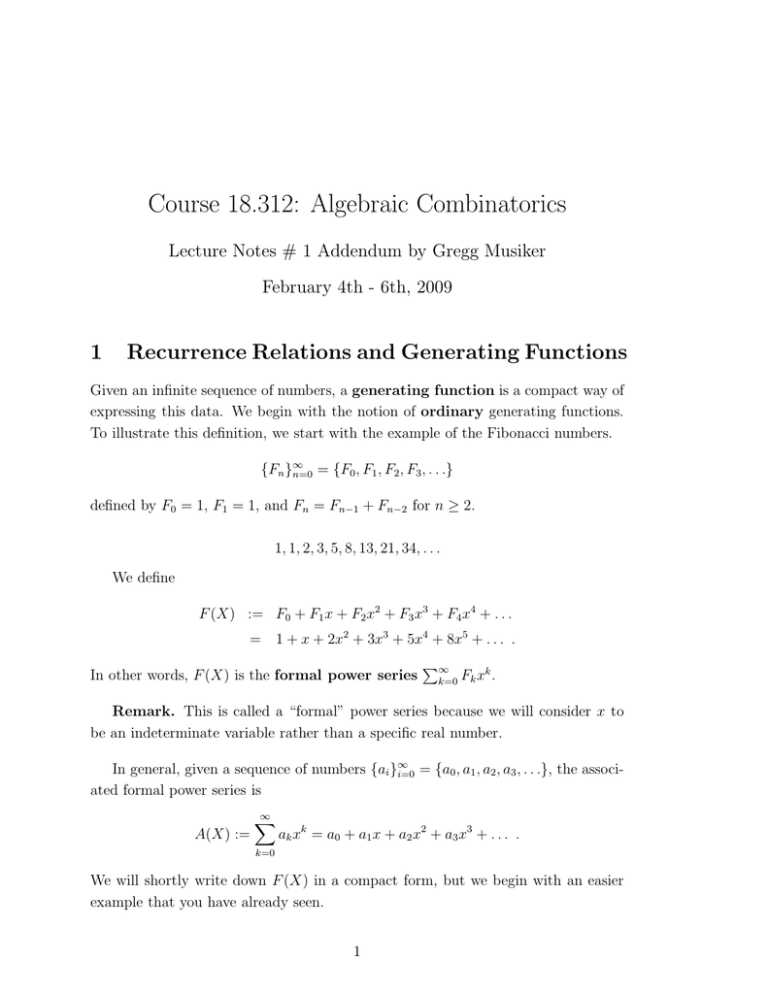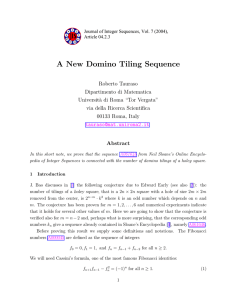Document 13570610
advertisement

Course 18.312: Algebraic Combinatorics
Lecture Notes # 1 Addendum by Gregg Musiker
February 4th - 6th, 2009
1
Recurrence Relations and Generating Functions
Given an infinite sequence of numbers, a generating function is a compact way of
expressing this data. We begin with the notion of ordinary generating functions.
To illustrate this definition, we start with the example of the Fibonacci numbers.
{Fn }∞
n=0 = {F0 , F1 , F2 , F3 , . . .}
defined by F0 = 1, F1 = 1, and Fn = Fn−1 + Fn−2 for n ≥ 2.
1, 1, 2, 3, 5, 8, 13, 21, 34, . . .
We define
F (X) := F0 + F1 x + F2 x2 + F3 x3 + F4 x4 + . . .
= 1 + x + 2x2 + 3x3 + 5x4 + 8x5 + . . . .
In other words, F (X) is the formal power series
�∞
k =0
Fk xk .
Remark. This is called a “formal” power series because we will consider x to
be an indeterminate variable rather than a specific real number.
In general, given a sequence of numbers {ai }∞
i=0 = {a0 , a1 , a2 , a3 , . . .}, the associ­
ated formal power series is
A(X) :=
∞
�
ak xk = a0 + a1 x + a2 x2 + a3 x3 + . . . .
k=0
We will shortly write down F (X) in a compact form, but we begin with an easier
example that you have already seen.
1
Recall that
�n�
k
n!
.
k!(n−k)!
=
��8��8
k
In fact if k > 8,
sequence as
� 8�
(e.g.
k
k=0
= {1, 8, 28, 56, 70, 56, 28, 8, 1}.
�8�
) equals zero. Thus we can consider the entire infinite
9
��8��∞
k
For example,
k=0
= {1, 8, 28, 56, 70, 56, 28, 8, 1, 0, 0, 0, . . .},
and then the associated formal power series
1 + 8x + 28x2 + 56x3 + 70x4 + 56x5 + 28x6 + 8x7 + x8 + 0x9 + 0x10 + . . .
can be written compactly as (1 + x)8 .
�� ��∞
n
Generalizing this to any positive integer n, k
has associated power series
k=0
�n �n� k
n
n
(1 + x) , since (1 + x) = k=0 k x by the Binomial Theorem.
This illustrates that from a formal power series, we can recover a sequence of
numbers. We call these numbers the coefficients of the formal power series. For
� n�
example, we say that
is the coefficient of xk in (1 + x)n . This is sometimes
k
�
� �
� �
�
written as (1 + x)n � = nk or [xk ](1 + x)n = nk .
xk
1.1
More complicated formal power series
�∞
k
We now want to write a similar expression for F (X) =
k=0 Fk x , where Fk =
Fk−1 + Fk−2 for k ≥ 2 and F0 = F1 = 1.
Notice that
∞
∞
∞
�
�
�
k
k
ak x ±
bk x =
(ak ± bk )xk .
k=0
k=0
k=0
As a consequence, Fk = Fk−1 + Fk−2 for k ≥ 2 implies
F (X) = 1 + F1 x +
∞
�
Fk xk
= 1 + F1 x +
∞
�
(Fk−1 + Fk−2 )xk
= 1 + F1 x +
∞
�
k=2
k=2
k=2
�
k
Fk−1 x +
∞
�
Fk−2 xk
k=2
�
= 1 + F1 x + xF (X) − F0 x + x2 F (X).
Thus
F (X)(1 − x − x2 ) = 1 + (F1 − F0 )x = 1 + 0x
and we obtain the rational expression
F (X) =
1
.
1 − x − x2
If we look at the Taylor series for this rational function, we indeed obtain coef­
ficients that are the Fibonacci numbers. Generating Functions are also helpful for
obtaining closed formulas or asymptotic formulas.
If we use partial fraction decomposition, we see that
F (X) =
B
A
+
.
1 − λ1 x 1 − λ2 x
We know that (1 − λ1 x)(1 − λ2 x) = 1 − x − x2 so
λ1 λ2 = −1
and
−λ1 − λ2 = −1
√
√
Thus {λ1 , λ2 } = { 1+2 5 , 1−2 5 }.
Exercise 1: Solve for A and B and use this to obtain a closed form expression
for Fk .
Notice that as a consequence we can compute that {Fk+1 /Fk } = {1/1, 2/1, 3/2, 5/3, 8/5, 13/8, . . .}
� √ �k
√
converges to 1+2 5 since 1−2 5 → 0 as k → ∞, so
Aλk+1
Aλk+1
+ Bλk+1
1
2
1
→
= λ1 .
k
k
Aλ1 + Bλ2
Aλk1
1.2
A Combinatorial Interpretation of the Fibonacci Num­
bers
Given a sequence of integers S = {s0 , s1 , s2 , . . .}, a combinatorial interpretation
of S is a family F of objects (of various sizes) such that the number of objects in F
of size k is exactly counted by sk .
� �
For example, a combinatorial interpretation of nk is as the number of subsets
of an {1, 2, . . . , n} of size k.
A domino tiling of a rectangular region R is a covering of R by horizontal
(1-by-2) domino tiles and vertical (2-by-1) domino tiles such that every square of R
is covered by exactly one domino.
For example, if we let R be a 2-by-2 grid, then there are two possible domino
tilings. Either both tiles are vertical or both are horizontal. If we let R be a 2-by-3
grid, then there are three possible domino tilings, and a 2-by-4 grid would have five
such domino tilings.
Proposition. The number of domino tilings of a 2-by-n grid is counted by the
nth Fibonacci number, Fn for n ≥ 1.
Proof. Let DTn denote the number of domino tilings of the 2-by-n grid. We
first check the initial conditions. There is one way to tile the 2-by-1 grid, and there
are two ways to tile the 2-by-2 grid. Thus DT1 = 1 = F1 and DT2 = 2 = F2 . (Recall
that F0 = 1, but we do not use this quantity in this combinatorial interpretation.)
Domino tilings of the 2-by-n grid either look like a domino tiling of the 2-by­
(n − 1) grid with a vertical tile tacked onto the end, or a domino tiling of the
2-by-(n − 2) grid with two horizontal tiles tacked onto the end. Consequently,
DTn = DTn−1 + DTn−2 , the same recurrence as the Fn ’s.
Exercise 2: Show that this combinatorial interpretation can be rephrased as
the statement
Fn = The number of subsets S of {a1 , a2 , . . . , an−1 }
such that ai and ai+1 are not both contained in S.
1.3
Convolution Product Formula
In addition to adding formal power series together, we can also multiply them. If
�
�∞
k
k
A(X) = ∞
k =0 ak x and B(X) =
k =0 bk x , where ak (resp. bk ) counts the number
of objects of type A (resp. B) and size k, then
A(X)B(X) = C(X) =
∞
�
cn xn
n=0
�
where cn = nk=0 ak bn−k , and has a combinatorial interpretation as the number of
objects of size n formed by taking an object of type A and concatenating it with an
object of type B.
1.4
Connection between Linear Recurrences and Rational
Generating Functions
The behavior we saw of the Fibonacci numbers and its generating function is an
example of a more general theorem.
Theorem. (Theorem 4.1.1 of Enumerative Combinatorics 1 by Richard
Stanley) Let α1 , α2 , . . . , αd be a fixed sequence of complex numbers, d ≥ 1, and
αd =
6 0. The following conditions on a function f : N → C are equivalent:
i) The generating function F (X) equals
∞
�
f (n)xn =
n=0
P (x)
Q(x)
where Q(x) = 1 + α1 x + α2 x2 + . . . + αd xd and P (x) is a polynomial of degree < d.
ii) For all n ≥ 0, f (n) satisfies the linear recurrence relation
f (n + d) + α1 f (n + d − 1) + α2 f (n + d − 2) + . . . + αd f (n) = 0.
iii) For all n ≥ 0,
f (n) =
k
�
Pi (n)γin
i=1
where
2
d
1 + α1 x + α2 x + . . . + αd x =
k
�
(1 − γi x)ei
i=1
with the γi’s distinct and each Pi (n) is a univariate polynomial (in n) of degree less
than ei .
Defintion. A generating function of the form
erating function.
P (x)
Q(x)
is a called a rational gen-
MIT OpenCourseWare
http://ocw.mit.edu
18.312 Algebraic Combinatorics
Spring 2009
For information about citing these materials or our Terms of Use, visit: http://ocw.mit.edu/terms.




